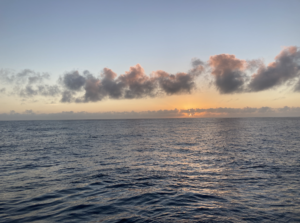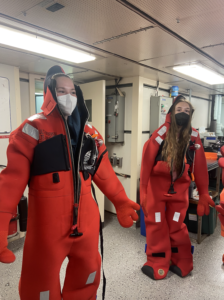
September 2:
This morning we were still in the middle of our 20-hour transit back to slope base, so I took the opportunity to sleep in. Then I had an easy day of working on my project presentation and hanging out with the other students. We used the recently fixed 3D printer and then cleaned off one of the junction boxes that ROPOS had pulled up.
During my evening shift my watch was logging a dive down to a shallow profiler. This was the first shallow profiler we had seen on our leg, so it was fun to witness how the mooring held up all of the instruments. There was a ton of feather stars and sea anemones attached to the mooring.
Last night during one of the other dives they sent down two niskins to collect water samples from 2750-meter depth, then boiled the water and collected the salt left behind into test tubes that were given out! My tube collection has now grown from one worm to a worm tube and a salt tube.
September 1:

Today was an exciting day as two of our watch leads collected their samples on a dive this afternoon. They were both collected samples from tube worm bushes off of ASHES vents. Once ROPOS had surfaced we then all got to help with prepping their samples. My job was to pour in ethanol into test tubes with scale worms in them in order to preserve the samples. Other people were labeling the tubes, sorting through worms, and taking photos.

Around 9:00 we started our second long transit of the leg back towards slope base, it’s a 20-hour transit so watches were postponed until the next afternoon. We got to use our free time and watched the sun set, played cards, and after I then lost horribly at scrabble. The sky was pretty clear so after I went outside up to the O2 deck and laid down to look at the stars, it was amazing how many you could see and how beautiful it was.
August 31:
This morning started with another watch shift of ROPOS coming up to the surface. After a short hour transit to International District ROPOS got sent back down. We then logged as ROPOS went around the chimneys at International District and places H.O.B.O.S. It was super cool to see the tall chimneys in the control room, and all of the life that was growing around them.
August 30:

This morning started out with watching ROPOS come back up on deck and then seeing even more dolphins playing up by the bow, a pretty great start to my day.
After my shift was over, I got to help with taking apart a CTD stand (tree) that had just been pulled up on deck.
I learned what all of the instruments on the tree do, a little bit on how they all work and then got to figure out how to take it all apart by doing, there was a steep learning curve and a lot of zip ties, but I definitely got some great hands-on experience!
After taking it apart and putting the used instruments into boxes, a few other students and I put on a hard hat and went out to the back of the ship while ROPOS was pulling up another CTD tree and watched deck operations in person.
We made sure to stay out of the way of the crew and hung out with a bird that has been following our ship for the last week.
Later before my second watch of the day all the students got to go up to the bridge and get a tour from the chief mate. We learned a lot about how the boat operates and heard some cool stories.
August 29 Cont:

After lunch I got to help out with preparing chlorophyll samples that we had gotten from an earlier CTD cast with niskin bottles. In order to prep the chlorophyll, the process had to be done in a dark room, I had to use a suction to pull the water through a filter and then preserve the filter in acetone then put it all into a freezer.
After a prepping a few samples it was time for all of us students to go on a tour of the engine room, we saw the engines, work room, motors among various other complicated elements that the engine room encompasses.

After dinner we saw another pod of dolphins off the side of the ship playing and feeding!
During my last shift of the day, my watch was on a dive down towards ASHES, we saw hydrothermal vents, a very adorable octopus, a blob fish, and a caldera, lots of super cool rocks!
August 29:

I woke up this morning to a ton of fog, we couldn’t see more than a few meters away from the boat and it looked very eerie. My first shift was watching the dive come up 2600 meters, it was a less exciting shift then some of the others as we only spotted a few dinner plate jellies before ROPOS came back to the surface.
My watch shift then got to preserve and keep some worms that came from a dive at the International District, El Guapo vent. My worm is now in my room in a tube taped to the wall, its excellent room decor. After learning some more fun worm facts, my watch shift and a few others went out on deck and learned how to rig interments onto the ROPOS tool basket!
August 28:

Today was a busy day, I started off with my morning shift watching another deep profiler replacement, during the dive the handle on a beacon that goes on top of the float of the deep profiler cable broke off while ROPOS was retrieving it, but the engineers were able to still retrieve the beacon without the handle. It was interesting to watch everyone remain calm, and problem solve in the moment.
After the dive I helped to prep the niskin bottles for the next CTD cast and then got to radio with the winch controller what depth to take the CTD and fired the niskin bottles.
Then I grabbed lunch, worked on my project, and created some more Styrofoam art.
Once the CTD had come all the way up and was back on deck, we started to collect samples. Our Styrofoam cups had also gone down with that CTD cast and the final products were adorable mini cups about an inch in diameter.

During my second shift of the day, we were watching ROPOS bring up an old junction box that it had just replaced. On the ascent two giant red jellyfish floated by the ROPOS camera, along with some shrimp, and lots of dinner plate jellyfish.
August 27:

Today was a transit day – we sailed for 18 hours from Slope Base to out to Axial Base. Because the water was a little rough most of us tried to sleep through the transit.
I also went out to the bow and got mildly soaked from the ocean spray. Tomorrow during another CTD cast we are sending down Styrofoam cups to 2600 meters and then taking them back up shrunken so we all decorated a cup and signed a ball to send to the bottom.

August 26:
For my first shift of the day, we were in transit so instead of watching a dive my watch got to help prepare samples for the CTD cast (conductivity, temperature, pressure (depth)). I learned how to properly take samples from different niskin bottles that fire at certain depths to collect water. After my watch and lunch, we hung out in the library and did a sloth puzzle.
Before my second watch I got to help out with building an OSMO instrument, a device that samples hydrothermal fluids coming out of the seafloor via osmotic pumps and stores it in samples coils.
We had to connect different tubes, make sure there were no air bubbles in the coils, and make sure everything was together.
After another nap I started my second watch of the day which was logging another deep profiler vehicle replacement. During the dive we saw another shark swim by!
August 25:

Yesterday was full of excitement and meeting new people and today is the first day that we are leaving the dock. After a six-hour drive yesterday we arrived at the NOAA facility, took another covid test of the many that we will be taking throughout the journey, and moved our stuff into our rooms. I then got to meet all the other people who will be on the ship, each carried the same warning, take Dramamine starting NOW, and after hearing several stories about students with sea sickness I made sure to take it.
After getting a tour of the boat, I had my first dinner onboard and then we had a great night of music with our very own DJ.

The next morning, we all got to practice putting on our immersion suits which was hilarious, as we looked like a sea of lobsters in the full body red wet suits. Upon setting sail at 12:45 this afternoon I went up to the deck and watched as we left port, going past resting sea lions on the buoys out towards the Oregon Shelf Offshore site.

I had my first shift from 2000 to 0000 (8 to midnight) and learned how to use the logging system for ROPOS. On the dive we saw a ton of fish and a shark that may have been the cause of a knocked down ROV light. It was super cool to be involved in the dive and in the room with the team.
